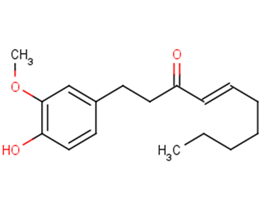
6-Shogaol
CAS No. 555-66-8
6-Shogaol( Shogaol | 6-Shogaol )
Catalog No. M18807 CAS No. 555-66-8
6-Shogaol has antipyretic and analgesic effects in addition to inhibitory effect on lipoxygenase activity.
Purity : >98% (HPLC)
 COA
COA
 Datasheet
Datasheet
 HNMR
HNMR
 HPLC
HPLC
 MSDS
MSDS
 Handing Instructions
Handing Instructions
| Size | Price / USD | Stock | Quantity |
| 5MG | 57 | In Stock |


|
| 10MG | 88 | In Stock |


|
| 25MG | 178 | In Stock |


|
| 50MG | 280 | In Stock |


|
| 100MG | 428 | In Stock |


|
| 200MG | Get Quote | In Stock |


|
| 500MG | Get Quote | In Stock |


|
| 1G | Get Quote | In Stock |


|
Biological Information
-
Product Name6-Shogaol
-
NoteResearch use only, not for human use.
-
Brief Description6-Shogaol has antipyretic and analgesic effects in addition to inhibitory effect on lipoxygenase activity.
-
DescriptionShogaol, also known as (6)-shogaol, is a pungent constituent of ginger similar in chemical structure to gingerol. Like zingerone, it is produced when ginger is dried or cooked. Shogaols are artifacts formed during storage or through excess heat, probably created by a dehydration reaction of the gingerols. The ratio of shogaols to gingerols sometimes is taken as an indication of product quality. Among ginger constituents, it has a very strong antitussive (anti-cough) effect. Both shogaol and gingerols reduced blood pressure and gastric contraction. Shogaol has been shown to induce apoptosis (kill) in human colorectal carcinoma cells via reactive oxygen species. It is broken down into 16 metabolites via the mercapturic acid pathway. Acetylcysteine was found to reduce effectiveness of shogaol's apoptotic properties.
-
In VitroShogaol (-Shogaol) has anticancer activity against several cell lines. Shogaol (-Shogaol) is identified to be cytotoxic in various cell lines, with KB (IC50=7.4±2.2 μM) and HL60 (IC50=7.9±2.0 μM) cells most susceptible to 6-shogaol. 6-shogaol (IC50=8 μM) has much stronger growth inhibitory effects than 6-gingerol (IC50=150 μM) on HCT-116 human colon cancer cells. Shogaol (-Shogaol) stimulates phosphorylations of mitogen-activated protein kinases (MAPKs) such as ERK, JNK, and p38. Moreover, the 6-shogaol-induced expressions of Nrf2 and HO-1 are attenuated by treatments of SB202190 (a p38 specific inhibitor) and LY294002 (an Akt specific inhibitor).
-
In VivoThe Shogaol (-Shogaol) decreases the diethylnitrosamine (DEN)-mediated elevations of serum aspartate transaminase and alanine transaminase as well as the DEN-induced hepatic lipid peroxidation. Inductions of Nrf2 and HO-1 by 6-shogaol are also confirmed in the mice. The administration of Shogaol (-Shogaol) to the mice also restores the DEN-reduced activity and protein expression of hepatic antioxidant enzymes such as superoxide dismutase, glutathione peroxidase and catalase.
-
SynonymsShogaol | 6-Shogaol
-
PathwayOthers
-
TargetOther Targets
-
RecptorLOX
-
Research AreaOthers-Field
-
Indication——
Chemical Information
-
CAS Number555-66-8
-
Formula Weight276.37
-
Molecular FormulaC17H24O3
-
Purity>98% (HPLC)
-
SolubilityDMSO : ≥ 50 mg/mL; 180.92 mM
-
SMILESCCCCCC=CC(=O)CCC1=CC(=C(C=C1)O)OC
-
Chemical Name1-(4-Hydroxy-3-methoxyphenyl)-4-decen-3-one
Shipping & Storage Information
-
Storage(-20℃)
-
ShippingWith Ice Pack
-
Stability≥ 2 years
Reference



-
BDC2.5 mimotope 1040...
This is a strongly agonistic peptide (mimotope) for diabetogenic T cell clone BDC2.5.
-
2-Methylsuccinic aci...
Methylsuccinic acid is a normal metabolite found in human fluids. Increased urinary levels of Methylsuccinic acid (together with ethylmalonic acid) are the main biochemical measurable features in ethylmalonic encephalopathy a rare metabolic disorder with an autosomal recessive mode of inheritance that is clinically characterized by neuromotor delay hyperlactic acidemia recurrent petechiae orthostatic acrocyanosis and chronic diarrhea.
-
(E)-Cinnamamide
(E)-Cinnamamide is the less active isomer of Cinnamamide which is an effective non-lethal chemical repellent suitable for reducing avian pest damage.



 Cart
Cart
 sales@molnova.com
sales@molnova.com


